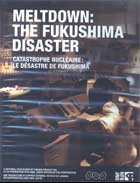
Meltdown: The Fukushima Disaster 2012
Distributed by National Film Board of Canada, 1123 Broadway, Suite 307, New York, NY 10010; 800-542-2164
Produced by Wally Longul and Steve Burns
Directed by Wally Longul, Akio Suzuki, and Akihiko Nakia
DVD, color, 45 min.
General Adult
Science, Technology, Nuclear Engineering, Nuclear Accidents, Environmental Disasters
Date Entered: 05/08/2014
Reviewed by Andrew Jenks, California State University, Long BeachFor a quarter century people confidently referred to the explosion of a nuclear reactor at Chernobyl on April 26, 1986 as the world’s worst nuclear disaster. But on March 11, 2011 a 10-meter high Tsunami easily engulfed the seawall protecting the Fukushima nuclear reactor, setting into motion a disastrous chain of events that led to the meltdown at three of the site’s six nuclear reactors. Debates have raged ever since about which of the nuclear disasters deserves the dubious honor of “worst in history,” though it is far from clear how one should measure calamity: in human lives lost, in the growing fear that accidents rather than terrorists represent the greatest existential threat to security, or in the failure of science to reveal the actual impact of the radiation itself on present and future generations.
The film ably recounts the sequence of events leading to the Fukushima disaster. The earthquake that triggered the Tsunami – the largest ever recorded in Japan – temporarily knocked out power for the reactor back-up systems. Just as operators seemed to regain control, the Tsunami then knocked them out again, along with the reactors. The backup power systems were needed to continually cool the reactors and, paradoxically, to prevent a runaway reaction in the event of an emergency reactor shut-down. Armed with flashlights, since all power had disappeared, operators frantically leafed through the operator’s manual but astoundingly they could find nothing about how to deal with such a situation. As the reactor headed toward meltdown the operators were literally operating blind. The reactor gauges did not function, making it impossible for the controllers to know the state of the reactor. It was precisely at this time that nuclear officials in Tokyo informed the public that the reactor was completely safe and under control – a replay of similar such claims by Mikhail Gorbachev in the days following the Chernobyl disaster.
As much a technological failure, the disaster resulted from a lack of engineering imagination – all the more astounding given the history of earthquakes and Tsunami in Japan. To save money and effort, designers saw the future through rose-tinted glasses, creating a 6-meter wall to protect the plant, no match for the 10-meter Tsunami that no designer had anticipated. The inability to imagine the scenario that would lead to disaster paralyzed the responders once the unthinkable occurred. That failure of imagination then combined with human error, incompetence, design flaws and improper attention to existing safety and operational procedures.
The story of the meltdown is unfortunately a common story that could be replicated in most large-scale technological disasters. Making this point might have strengthened the documentary. Instead, the film focuses on Fukushima as a unique event, and it has almost nothing to say about the biological and environmental impact of the disaster. This reviewer, at least, would have liked more attention to the social and biological consequences of Fukushima, which is, after all, why it was such a disaster. In the aftermath of large-scale nuclear and chemical disasters people turn to science for answers about the long-term environmental and biological impact of released toxins. And invariably they experience a deep disillusionment when confronted with wildly divergent estimates about possible impacts – from predictions of mass death and suffering to a nearly complete dismissal of any long term negative consequence. Fukushima was no exception, but this documentary provides little on the social, environmental, scientific and political aftermath of the meltdown.
Given the inevitability of flawed engineering and human operators – not to mention the economic pressures associated with the operation of dangerous large-scale technologies – the benefits of certain technologies may not be worth the risk of catastrophic failure. Even worse, technological fixes designed to minimize risks very often introduce new complexities into the operation and interaction of human-machine interfaces, thus increasing the potential for unforeseen mistakes and circumstances. The film, however, steers clear of polemics about nuclear power and instead focuses on a blow-by-blow account. In so doing, it avoids the moral – rather than technical – challenges raised by the deployment of any dangerous, large-scale technological system. So for those seeking a detailed technical explanation for the Fukushima meltdown this documentary is perfect. But those interested in the broader social, political, and environmental context of Fukushima, as well as an assessment of the risks and tradeoffs of nuclear power, will have to go elsewhere.